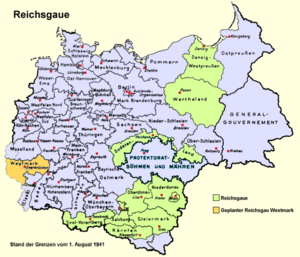Saargebiet facts for kids
Quick facts for kids
The Territory of the Saar Basin
|
|||||||||
|---|---|---|---|---|---|---|---|---|---|
| 1920–1935 | |||||||||
|
Flag
|
|||||||||
| Capital | Saarbrücken | ||||||||
| Commission Chairman | |||||||||
|
• 1920-1926
|
Victor Rault | ||||||||
|
• 1926-1927
|
George W. Stephens | ||||||||
|
• 1927-1932
|
Sir Ernest Collins Wilton | ||||||||
| Historical era | Interwar period | ||||||||
|
• Treaty of Versailles
|
January 10 1920 | ||||||||
|
• Plebiscite
|
January 13, 1935 | ||||||||
|
• Disestablished
|
March 1 1935 | ||||||||
| Population | |||||||||
|
• 1933
|
812000 | ||||||||
| Currency | Saar franc | ||||||||
|
|||||||||
The Territory of the Saar Basin was a special area in Europe. It was often called the Saar or Saargebiet. This territory was managed by the League of Nations for 15 years, starting in 1920. The League of Nations was an international group that worked for world peace.
The Saar Basin was created after World War I by the Treaty of Versailles. This treaty was a peace agreement signed in 1919. In 1933, about 812,000 people lived there. Its main city and capital was Saarbrücken.
The Saar Basin was made from parts of Germany. It was a bit smaller than the modern German state called Saarland.
Contents
Governing the Saar Basin
The Saarland region was very important for its industries, especially coal mining. The Treaty of Versailles decided that the League of Nations would govern it for 15 years. This was also because France was given control of the Saar's coal mines.
The League of Nations set up a group called the Commission of Government to rule the Saar. This group had five members. At least one member had to be from France. Also, one member had to be a local person from the Saar.
At the end of the 15 years, in 1935, the people of the Saar voted on their future. They chose to join Nazi Germany. During this time, the Saar also had its own money, called the Saar franc. It even had its own postage stamps.
Leaders of the Commission
The League of Nations chose different leaders to manage the Saar Basin. These leaders were called Chairmen of the Commission of Government. Here are the people who held this important role:
- Victor Rault from France (from February 26, 1920 to March 18, 1926)
- George Washington Stephens from Canada (from March 18, 1926 to June 8, 1927)
- Sir Ernest Colville Collins Wilton from the United Kingdom (from June 8, 1927 to April 1, 1932)
- Sir Geoffrey George Knox from the United Kingdom (from April 1, 1932 to March 1, 1935)
The Big Vote: Plebiscite
In 1933, many Germans who were against the Nazi party moved to the Saar. This was because the Saar was the only part of Germany not controlled by the Third Reich. These anti-Nazi groups wanted the Saarland to stay under the League of Nations' control. They hoped it would remain separate as long as Adolf Hitler was in charge of Germany.
However, France had a lot of influence in the Saar. France controlled the coal mines and the Saar even used the French franc as its money. Many people in the Saar did not like France's strong presence.
On January 13, 1935, a special vote called a plebiscite was held. People voted on what they wanted for their future. The results were very clear:
- About 90% of voters wanted to join Nazi Germany.
- About 8.86% wanted to stay under the League of Nations' control.
- Only 0.40% (which means 4 out of every 1,000 voters) wanted to join France.
Joining Nazi Germany

On January 17, 1935, the League Council (part of the League of Nations) agreed that the Saar territory could rejoin Nazi Germany. On March 1, Nazi Germany took control of the region.
They appointed Josef Bürckel as the "Reich Commissioner for the re-union of Saarland." This meant he was in charge of bringing the Saarland back into Germany. Many politicians and officials who had worked in the Saar Basin before were removed from their jobs or arrested by the Nazis.
Once the Saarland was fully part of Germany again, its leader became the "Reich Commissioner of Saarland." This change happened on June 17, 1936.
Other Related Pages
- Saarland: This is the modern state in Germany.
- Saar: This was another area under French control from 1947 to 1956.
- Sarre: This was a French department from 1798 to 1814.
- Saar River: A river that flows through the region.
- Nazi Germany: The period when Germany was ruled by the Nazi Party.
- Free City of Danzig: Another special territory created after World War I.
See also
 In Spanish: Territorio de la Cuenca del Sarre para niños
In Spanish: Territorio de la Cuenca del Sarre para niños


